Management Analysis: Coca-Cola's Problems and Potential Solutions
VerifiedAdded on 2022/11/29
|6
|1384
|272
Report
AI Summary
This report examines the key challenges faced by Coca-Cola, including the impact of high taxation on sugary drinks, leading to increased costs and margin pressure, especially in emerging markets like India. The report also addresses criticisms related to the high sugar and caffeine content of Coca-Cola products and the resulting health concerns such as obesity and diabetes, which have led to declining sales. The analysis explores the need for Coca-Cola to strengthen its supplier network, adapt to health trends, expand globally, and invest in marketing for healthier beverage options. The report emphasizes the importance of addressing water management issues and promoting sustainable practices, such as recycling programs. It also recommends leveraging artificial intelligence and strategic partnerships to enhance productivity, digitize the supply chain, and foster innovation to maintain a competitive edge and improve brand image. References from various management journals are included to support the analysis.
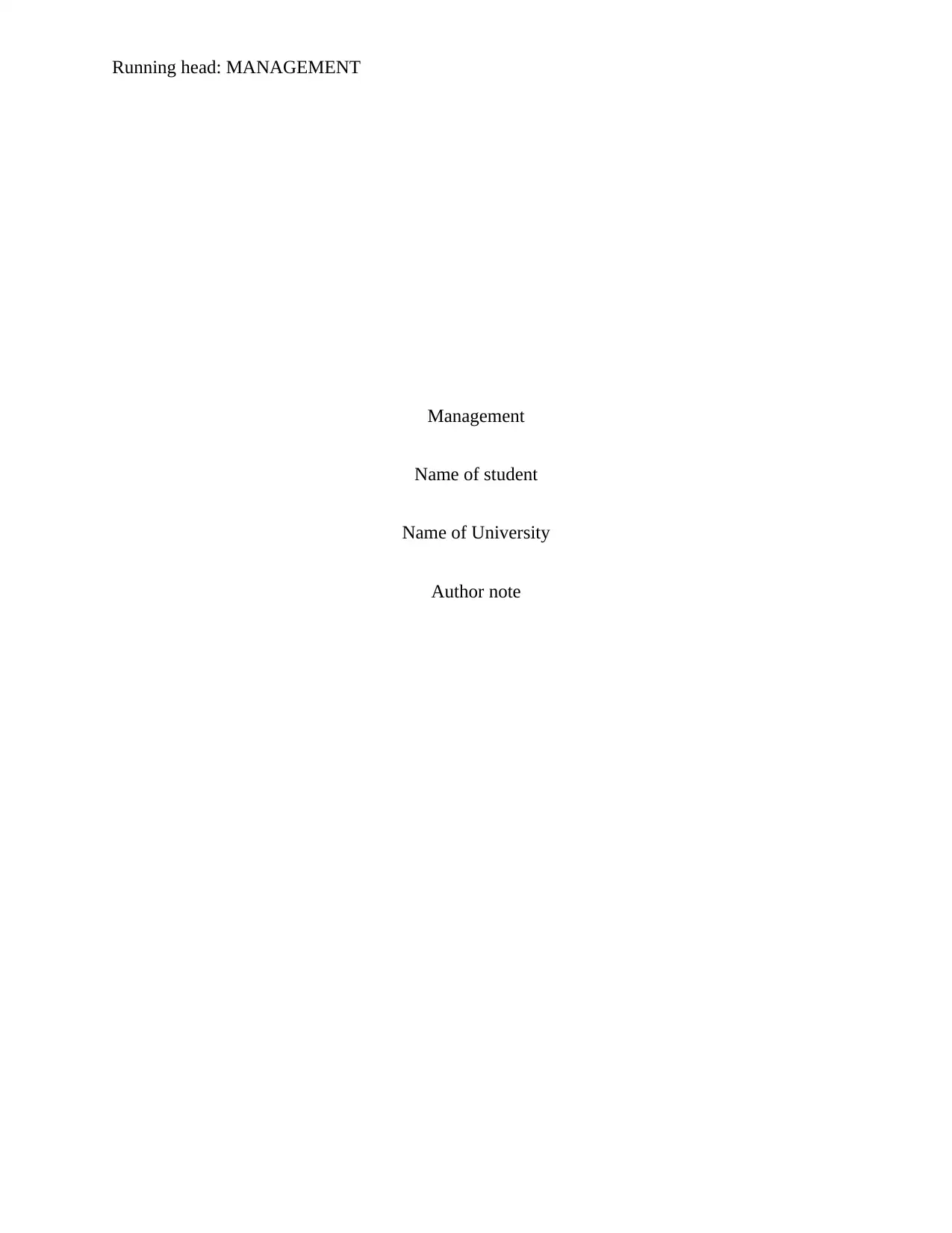
Running head: MANAGEMENT
Management
Name of student
Name of University
Author note
Management
Name of student
Name of University
Author note
Paraphrase This Document
Need a fresh take? Get an instant paraphrase of this document with our AI Paraphraser
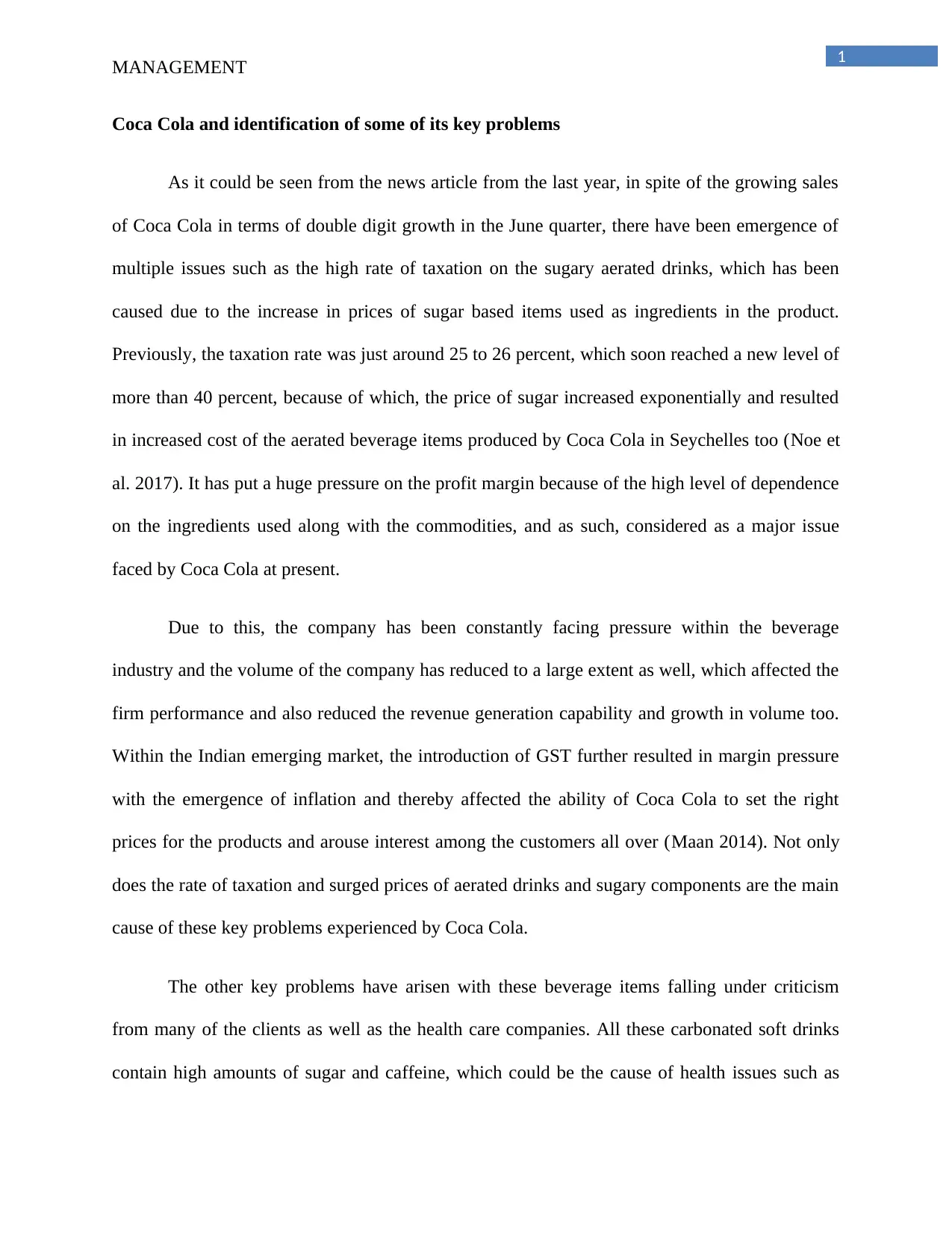
1
MANAGEMENT
Coca Cola and identification of some of its key problems
As it could be seen from the news article from the last year, in spite of the growing sales
of Coca Cola in terms of double digit growth in the June quarter, there have been emergence of
multiple issues such as the high rate of taxation on the sugary aerated drinks, which has been
caused due to the increase in prices of sugar based items used as ingredients in the product.
Previously, the taxation rate was just around 25 to 26 percent, which soon reached a new level of
more than 40 percent, because of which, the price of sugar increased exponentially and resulted
in increased cost of the aerated beverage items produced by Coca Cola in Seychelles too (Noe et
al. 2017). It has put a huge pressure on the profit margin because of the high level of dependence
on the ingredients used along with the commodities, and as such, considered as a major issue
faced by Coca Cola at present.
Due to this, the company has been constantly facing pressure within the beverage
industry and the volume of the company has reduced to a large extent as well, which affected the
firm performance and also reduced the revenue generation capability and growth in volume too.
Within the Indian emerging market, the introduction of GST further resulted in margin pressure
with the emergence of inflation and thereby affected the ability of Coca Cola to set the right
prices for the products and arouse interest among the customers all over (Maan 2014). Not only
does the rate of taxation and surged prices of aerated drinks and sugary components are the main
cause of these key problems experienced by Coca Cola.
The other key problems have arisen with these beverage items falling under criticism
from many of the clients as well as the health care companies. All these carbonated soft drinks
contain high amounts of sugar and caffeine, which could be the cause of health issues such as
MANAGEMENT
Coca Cola and identification of some of its key problems
As it could be seen from the news article from the last year, in spite of the growing sales
of Coca Cola in terms of double digit growth in the June quarter, there have been emergence of
multiple issues such as the high rate of taxation on the sugary aerated drinks, which has been
caused due to the increase in prices of sugar based items used as ingredients in the product.
Previously, the taxation rate was just around 25 to 26 percent, which soon reached a new level of
more than 40 percent, because of which, the price of sugar increased exponentially and resulted
in increased cost of the aerated beverage items produced by Coca Cola in Seychelles too (Noe et
al. 2017). It has put a huge pressure on the profit margin because of the high level of dependence
on the ingredients used along with the commodities, and as such, considered as a major issue
faced by Coca Cola at present.
Due to this, the company has been constantly facing pressure within the beverage
industry and the volume of the company has reduced to a large extent as well, which affected the
firm performance and also reduced the revenue generation capability and growth in volume too.
Within the Indian emerging market, the introduction of GST further resulted in margin pressure
with the emergence of inflation and thereby affected the ability of Coca Cola to set the right
prices for the products and arouse interest among the customers all over (Maan 2014). Not only
does the rate of taxation and surged prices of aerated drinks and sugary components are the main
cause of these key problems experienced by Coca Cola.
The other key problems have arisen with these beverage items falling under criticism
from many of the clients as well as the health care companies. All these carbonated soft drinks
contain high amounts of sugar and caffeine, which could be the cause of health issues such as
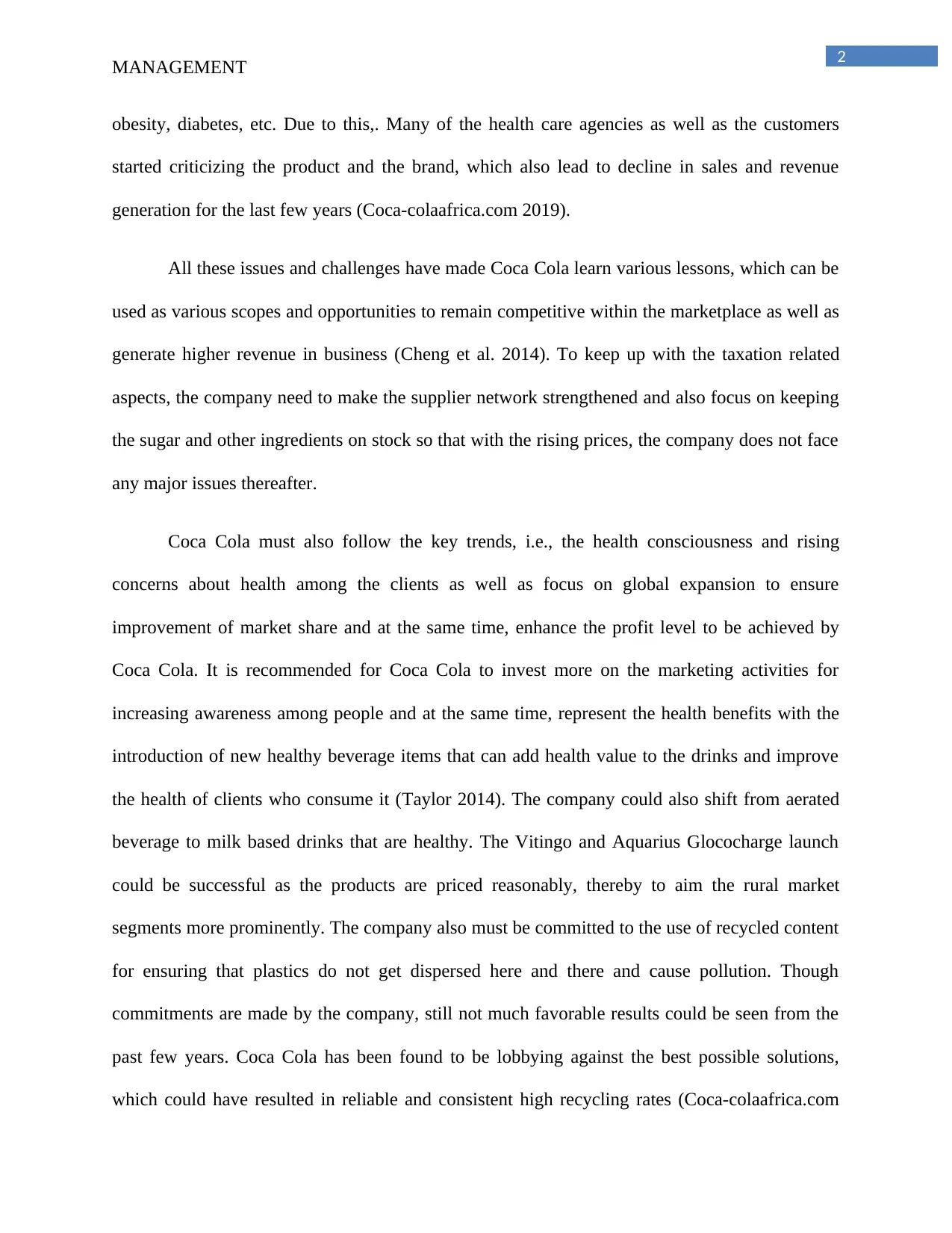
2
MANAGEMENT
obesity, diabetes, etc. Due to this,. Many of the health care agencies as well as the customers
started criticizing the product and the brand, which also lead to decline in sales and revenue
generation for the last few years (Coca-colaafrica.com 2019).
All these issues and challenges have made Coca Cola learn various lessons, which can be
used as various scopes and opportunities to remain competitive within the marketplace as well as
generate higher revenue in business (Cheng et al. 2014). To keep up with the taxation related
aspects, the company need to make the supplier network strengthened and also focus on keeping
the sugar and other ingredients on stock so that with the rising prices, the company does not face
any major issues thereafter.
Coca Cola must also follow the key trends, i.e., the health consciousness and rising
concerns about health among the clients as well as focus on global expansion to ensure
improvement of market share and at the same time, enhance the profit level to be achieved by
Coca Cola. It is recommended for Coca Cola to invest more on the marketing activities for
increasing awareness among people and at the same time, represent the health benefits with the
introduction of new healthy beverage items that can add health value to the drinks and improve
the health of clients who consume it (Taylor 2014). The company could also shift from aerated
beverage to milk based drinks that are healthy. The Vitingo and Aquarius Glococharge launch
could be successful as the products are priced reasonably, thereby to aim the rural market
segments more prominently. The company also must be committed to the use of recycled content
for ensuring that plastics do not get dispersed here and there and cause pollution. Though
commitments are made by the company, still not much favorable results could be seen from the
past few years. Coca Cola has been found to be lobbying against the best possible solutions,
which could have resulted in reliable and consistent high recycling rates (Coca-colaafrica.com
MANAGEMENT
obesity, diabetes, etc. Due to this,. Many of the health care agencies as well as the customers
started criticizing the product and the brand, which also lead to decline in sales and revenue
generation for the last few years (Coca-colaafrica.com 2019).
All these issues and challenges have made Coca Cola learn various lessons, which can be
used as various scopes and opportunities to remain competitive within the marketplace as well as
generate higher revenue in business (Cheng et al. 2014). To keep up with the taxation related
aspects, the company need to make the supplier network strengthened and also focus on keeping
the sugar and other ingredients on stock so that with the rising prices, the company does not face
any major issues thereafter.
Coca Cola must also follow the key trends, i.e., the health consciousness and rising
concerns about health among the clients as well as focus on global expansion to ensure
improvement of market share and at the same time, enhance the profit level to be achieved by
Coca Cola. It is recommended for Coca Cola to invest more on the marketing activities for
increasing awareness among people and at the same time, represent the health benefits with the
introduction of new healthy beverage items that can add health value to the drinks and improve
the health of clients who consume it (Taylor 2014). The company could also shift from aerated
beverage to milk based drinks that are healthy. The Vitingo and Aquarius Glococharge launch
could be successful as the products are priced reasonably, thereby to aim the rural market
segments more prominently. The company also must be committed to the use of recycled content
for ensuring that plastics do not get dispersed here and there and cause pollution. Though
commitments are made by the company, still not much favorable results could be seen from the
past few years. Coca Cola has been found to be lobbying against the best possible solutions,
which could have resulted in reliable and consistent high recycling rates (Coca-colaafrica.com
⊘ This is a preview!⊘
Do you want full access?
Subscribe today to unlock all pages.

Trusted by 1+ million students worldwide
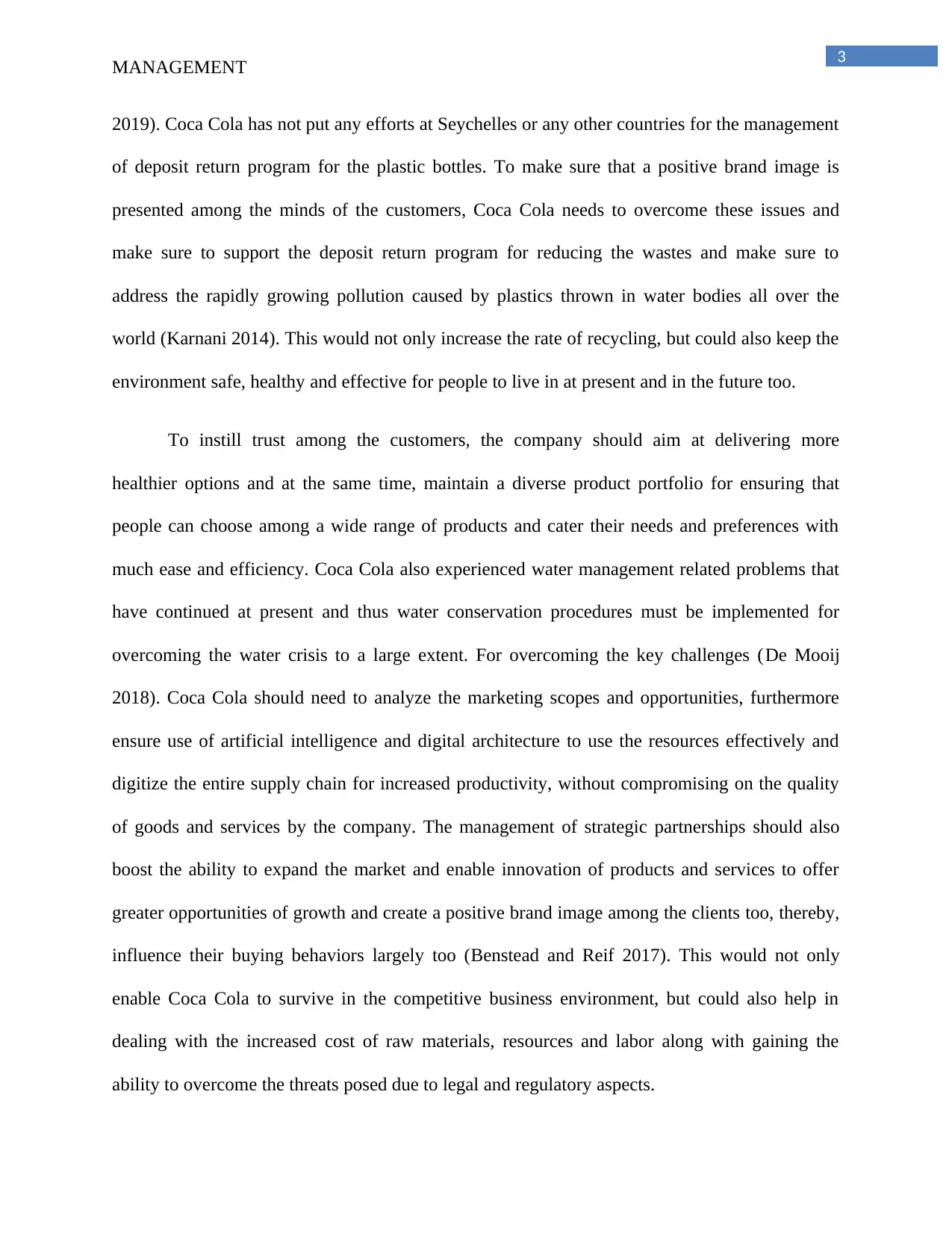
3
MANAGEMENT
2019). Coca Cola has not put any efforts at Seychelles or any other countries for the management
of deposit return program for the plastic bottles. To make sure that a positive brand image is
presented among the minds of the customers, Coca Cola needs to overcome these issues and
make sure to support the deposit return program for reducing the wastes and make sure to
address the rapidly growing pollution caused by plastics thrown in water bodies all over the
world (Karnani 2014). This would not only increase the rate of recycling, but could also keep the
environment safe, healthy and effective for people to live in at present and in the future too.
To instill trust among the customers, the company should aim at delivering more
healthier options and at the same time, maintain a diverse product portfolio for ensuring that
people can choose among a wide range of products and cater their needs and preferences with
much ease and efficiency. Coca Cola also experienced water management related problems that
have continued at present and thus water conservation procedures must be implemented for
overcoming the water crisis to a large extent. For overcoming the key challenges (De Mooij
2018). Coca Cola should need to analyze the marketing scopes and opportunities, furthermore
ensure use of artificial intelligence and digital architecture to use the resources effectively and
digitize the entire supply chain for increased productivity, without compromising on the quality
of goods and services by the company. The management of strategic partnerships should also
boost the ability to expand the market and enable innovation of products and services to offer
greater opportunities of growth and create a positive brand image among the clients too, thereby,
influence their buying behaviors largely too (Benstead and Reif 2017). This would not only
enable Coca Cola to survive in the competitive business environment, but could also help in
dealing with the increased cost of raw materials, resources and labor along with gaining the
ability to overcome the threats posed due to legal and regulatory aspects.
MANAGEMENT
2019). Coca Cola has not put any efforts at Seychelles or any other countries for the management
of deposit return program for the plastic bottles. To make sure that a positive brand image is
presented among the minds of the customers, Coca Cola needs to overcome these issues and
make sure to support the deposit return program for reducing the wastes and make sure to
address the rapidly growing pollution caused by plastics thrown in water bodies all over the
world (Karnani 2014). This would not only increase the rate of recycling, but could also keep the
environment safe, healthy and effective for people to live in at present and in the future too.
To instill trust among the customers, the company should aim at delivering more
healthier options and at the same time, maintain a diverse product portfolio for ensuring that
people can choose among a wide range of products and cater their needs and preferences with
much ease and efficiency. Coca Cola also experienced water management related problems that
have continued at present and thus water conservation procedures must be implemented for
overcoming the water crisis to a large extent. For overcoming the key challenges (De Mooij
2018). Coca Cola should need to analyze the marketing scopes and opportunities, furthermore
ensure use of artificial intelligence and digital architecture to use the resources effectively and
digitize the entire supply chain for increased productivity, without compromising on the quality
of goods and services by the company. The management of strategic partnerships should also
boost the ability to expand the market and enable innovation of products and services to offer
greater opportunities of growth and create a positive brand image among the clients too, thereby,
influence their buying behaviors largely too (Benstead and Reif 2017). This would not only
enable Coca Cola to survive in the competitive business environment, but could also help in
dealing with the increased cost of raw materials, resources and labor along with gaining the
ability to overcome the threats posed due to legal and regulatory aspects.
Paraphrase This Document
Need a fresh take? Get an instant paraphrase of this document with our AI Paraphraser
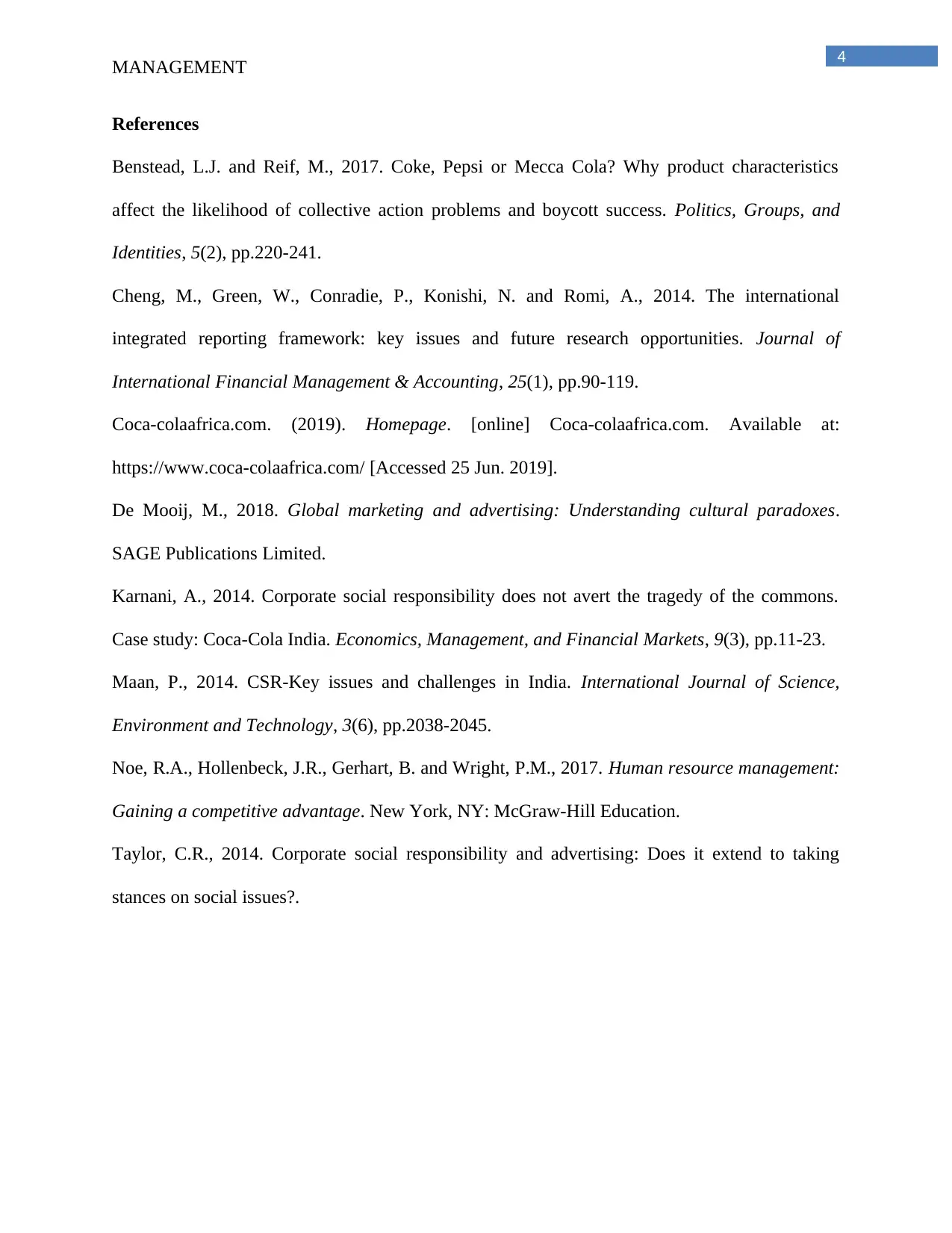
4
MANAGEMENT
References
Benstead, L.J. and Reif, M., 2017. Coke, Pepsi or Mecca Cola? Why product characteristics
affect the likelihood of collective action problems and boycott success. Politics, Groups, and
Identities, 5(2), pp.220-241.
Cheng, M., Green, W., Conradie, P., Konishi, N. and Romi, A., 2014. The international
integrated reporting framework: key issues and future research opportunities. Journal of
International Financial Management & Accounting, 25(1), pp.90-119.
Coca-colaafrica.com. (2019). Homepage. [online] Coca-colaafrica.com. Available at:
https://www.coca-colaafrica.com/ [Accessed 25 Jun. 2019].
De Mooij, M., 2018. Global marketing and advertising: Understanding cultural paradoxes.
SAGE Publications Limited.
Karnani, A., 2014. Corporate social responsibility does not avert the tragedy of the commons.
Case study: Coca-Cola India. Economics, Management, and Financial Markets, 9(3), pp.11-23.
Maan, P., 2014. CSR-Key issues and challenges in India. International Journal of Science,
Environment and Technology, 3(6), pp.2038-2045.
Noe, R.A., Hollenbeck, J.R., Gerhart, B. and Wright, P.M., 2017. Human resource management:
Gaining a competitive advantage. New York, NY: McGraw-Hill Education.
Taylor, C.R., 2014. Corporate social responsibility and advertising: Does it extend to taking
stances on social issues?.
MANAGEMENT
References
Benstead, L.J. and Reif, M., 2017. Coke, Pepsi or Mecca Cola? Why product characteristics
affect the likelihood of collective action problems and boycott success. Politics, Groups, and
Identities, 5(2), pp.220-241.
Cheng, M., Green, W., Conradie, P., Konishi, N. and Romi, A., 2014. The international
integrated reporting framework: key issues and future research opportunities. Journal of
International Financial Management & Accounting, 25(1), pp.90-119.
Coca-colaafrica.com. (2019). Homepage. [online] Coca-colaafrica.com. Available at:
https://www.coca-colaafrica.com/ [Accessed 25 Jun. 2019].
De Mooij, M., 2018. Global marketing and advertising: Understanding cultural paradoxes.
SAGE Publications Limited.
Karnani, A., 2014. Corporate social responsibility does not avert the tragedy of the commons.
Case study: Coca-Cola India. Economics, Management, and Financial Markets, 9(3), pp.11-23.
Maan, P., 2014. CSR-Key issues and challenges in India. International Journal of Science,
Environment and Technology, 3(6), pp.2038-2045.
Noe, R.A., Hollenbeck, J.R., Gerhart, B. and Wright, P.M., 2017. Human resource management:
Gaining a competitive advantage. New York, NY: McGraw-Hill Education.
Taylor, C.R., 2014. Corporate social responsibility and advertising: Does it extend to taking
stances on social issues?.
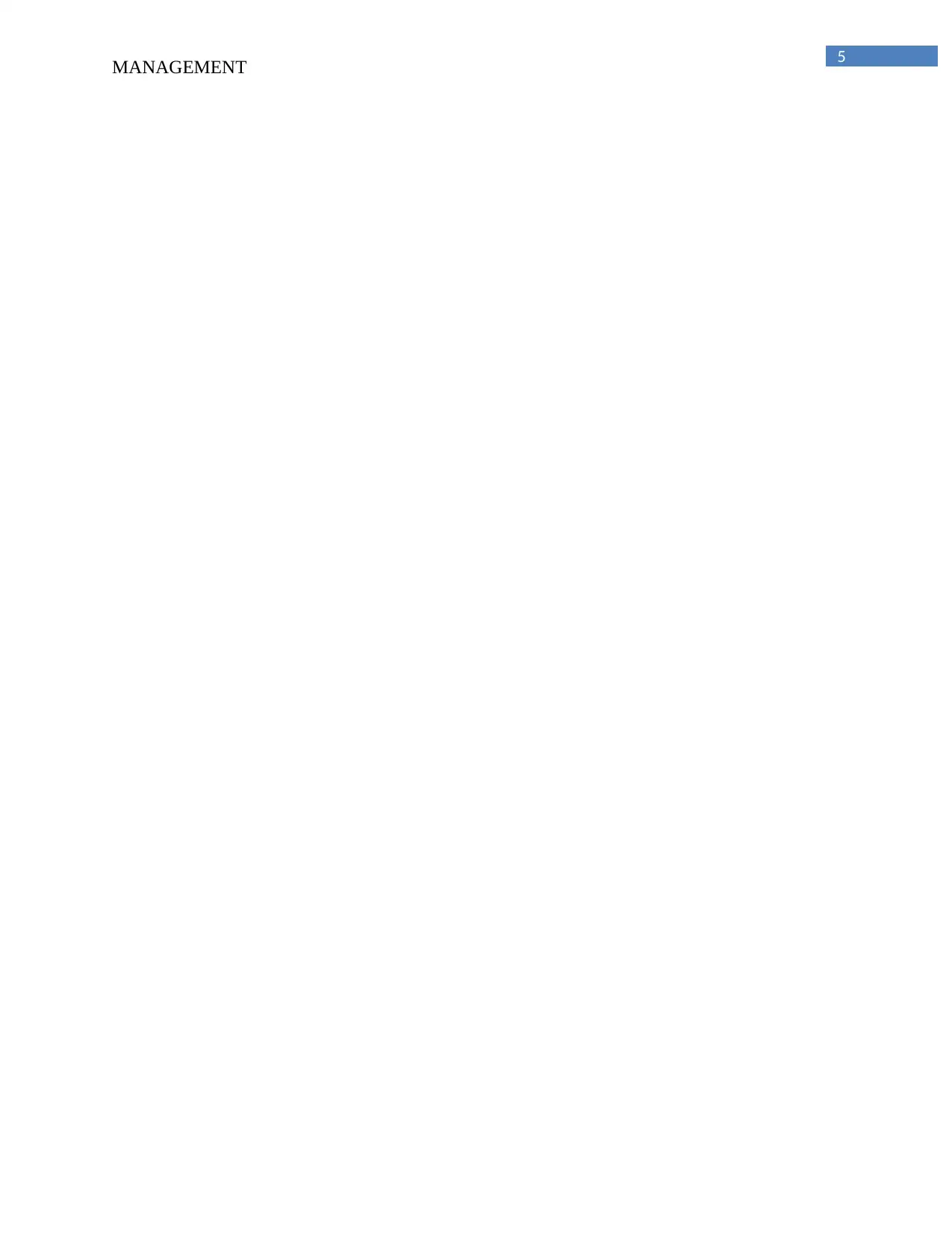
5
MANAGEMENT
MANAGEMENT
⊘ This is a preview!⊘
Do you want full access?
Subscribe today to unlock all pages.

Trusted by 1+ million students worldwide
1 out of 6
Related Documents
Your All-in-One AI-Powered Toolkit for Academic Success.
+13062052269
info@desklib.com
Available 24*7 on WhatsApp / Email
![[object Object]](/_next/static/media/star-bottom.7253800d.svg)
Unlock your academic potential
Copyright © 2020–2025 A2Z Services. All Rights Reserved. Developed and managed by ZUCOL.



